MAGNEPLANAR 0.7 LRS Review – Magnetic
A panel loudspeaker with magnetic properties. The Magneplanar LRS loudspeaker is a uniquely attractive, thinks Noel Keywood. Read our MAGNEPLANAR 0.7 LRS Review.
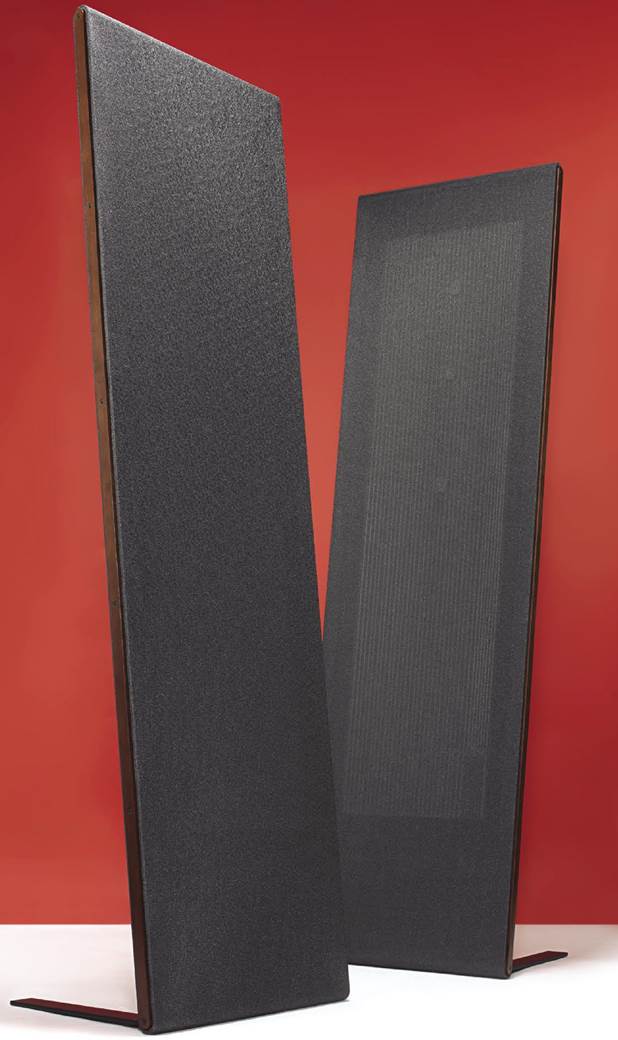
Long ago Quad converted me to the open panel loudspeaker. Yes, they have drawbacks but also unbeatable strengths. And then there is the magnetic planar drive unit now becoming popular in headphones. Put them together and you have a Magneplanar loudspeaker, from Magnepan of the USA – an open panel using magnetic planar drive units. Different. Magnepan’s bigger models never won me over but the new LRS I am reviewing here has extraordinary sound quality, yet UK distributor Decent Audio are asking just £ for a pair. This is a loudspeaker you should know about.
The new LRS is so good I would bill it as a step up on the traditional box loudspeaker. But there are drawbacks, as I will explain. It isn’t going to happen – or is it? The LRS makes a strong argument for the panel loudspeaker, one made in the past – see my column this month.
As you can see from our pics, this new mini from Maggie is a slim, flat panel. Sound radiates equally from front and back, there is no rear cover to prevent sound getting out rearward. Inside there is a magnetic planar bass panel and a narrow vertical ribbon tweeter, positioned at side. They come in handed pairs but are not obviously marked as such: the rear Serial Number identifies I as Left speaker and 2 as Right speaker, Magnepan say, placing tweeters on the outside – but I preferred them on the inside – more later. Because the drivers stretch from bottom to top the sound stage is vertically larger than that of cone loudspeakers: think big sound staging.
In the past open panels have carried cone drivers (Wharfedale) and electrostatic drivers (Quad) but in a Maggie you get a flat, lightweight Mylar film with surface conductors, reacting against fixed bar magnets – a ‘magnetic planar’ drive unit. In the 0.7 it works up to 700Hz. It is an electric motor like a cone driver, albeit one laid out flat. Making this a loudspeaker like few others. Eminent Technology (USA) come close with their superb magnetic planar hybrids, where deep bass is handled by a box driver – something the 0.7 lacks.
Absence of a box bass unit keeps cost down by avoiding cabinet making – an expensive business – and it also reduces weight. The 0.7s were easily liftable.
I would like to say this panel is small – as the 0.7 seemed to me – but this depends literally on how you view it. Sideways on the 0.7 is vanishingly small, just 32mm (1.25in) deep. But an open panel must have large surface area to develop bass, to reduce the frequency at which the rear wave cancels the front wave. That’s why the 0.7 measures I.2m (48 in) high and 37cm (I4.5 in) wide, looking like a large box loudspeaker from front.
In an I8ft long room – which would be ideal – they’d fit in easily enough, bearing in mind there should be one metre or so behind to allow the rear wave to disperse. Rear absorption panels, curtains or soft furnishings help; at one time I hung a curtain of thick natural carpet felt I5cm behind my Quad ESL-63 open panels – but moths ate it!
To support the 0.7, Magnepan provide a pair of rudimentary feet made from bent iron sprayed black that spring backward and forward alarming. There are no feet nor spikes, but optional “flippers” to tilt them forward. The feet are rudimentary, especially when compared to the cast alloy sub-assemblies used by other manufactuers to keep their loudspeakers firmly planted. Rigid side supports with spikes/pads, as an option package, would be a good idea I can’t help thinking. And the
LRS is best tilted backward, not forward, measurement suggested and listening confirmed.
The standard of finish is adequate, if without any attempt at detailing – not even a company name badge or model ID at front.
The rear connecting panel is also a pretty basic affair that accepts 4mm banana plugs or bare wire – with locking grub screws turned by a hex key (supplied) that can be used to clamp plugs – but one of my plugs would not fit in any case there’s so little clearance. An adaptor is available for spades.
Polarity markings are small and there is no red/black colour coding. However, a removable link can be replaced by a supplied I.2 Ohm resistor to attenuate output from the treble unit if desired – see Measured Performance for more details. I found no need for a warmer sound and left the link in
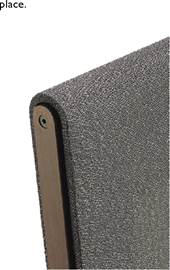
Just 32mm or 1.25in deep, the LRS is slim, even by panel loudspeaker standards. Magnepan say do not use against a side wall, to increase panel area and strengthen bass – a trad trick with panels. But in a narrow room, worth trying.
The Magneplanar’s unusual connecting panel. Hex key grub screws tighten banana plugs or bare wires in the 4mm sockets.
Replacing the tweeter terminator link with a 1 ohm resistor lowers treble by 2dB.
Small lettering and no red/ black colour coding – not easy to see.
Magnepan allude to the need for a powerful amplifier to drive the 0.7 – and they are right. Magnetic planar drive units are insensitive, because of the clearances needed in their motors, but with the 0.7 small panel size also reduces sensitivity. However, a 100 Watt amplifier is sufficient and there’s no shortage of good ones able to drive the
“gloriously pure quality quite beyond box loudspeakers”
0.7s; modern designs drive their 4 Ohm load with ease. So do valve amplifiers with a 4 Ohm tap, for which the pure resistance of these ‘speakers is a perfect load. But the power meters of our 30 Watt Icon Audio Stereo 30SE flicked toward their end stops before I could annoy the neighbours. I would like to say a big McIntosh or Audio Research would be great, as would an Icon Audio MB90 monoblock – but for a £ loudspeaker? Seems daft but these speakers deserve a top quality valve amplifier.
Finally, there is a dark patch behind each grille, indicating the side treble is strongest from front (in addition to Serial Number) and this affected the sound stage quite
obviously. Peer closely or use a rear torch shining forward and you can see the tweeter as a vertical strip of finer conductors, the dark patch possibly a connector panel.
And in addition to Finally: “cats will sometimes use Magneplanars for scratching posts” Magnepan say. “We suggest cat repellent from your local pet shop”. So cats like ‘em – if for the wrong reasons!
SOUND QUALITY
I ran the 0.7s from our Creek Evolution I00A (100 Watt)
transistor amplifier and – alternatively
– Icon Audio Stereo 30SE (30 Watt) valve amplifier, both connected through Chord Company Signature Reference cables. Sources were our Oppo BDP-205D CD player, an Astell&Kern AK-120 portable player feeding in hi-res digital from its fully floating battery supply through optical cable, for digital. Analogue came from a Timestep Evo modified Technics SL-I2I0 MkII turntable with SME309 arm and Audio Technica OC-9X SH (Shibata stylus profile) moving coil cartridge, feeding Icon Audio PS3 MkII valve phono stage with silent input transformers.
First, the sound stage. The vertical line treble unit gives
unusually stable and focussed images over great height – around I metre. Singers and instruments take on large form as a result and they are rock stable. As expected I found the sound stage most intense with the tweeter (patch) on the inside, in keeping with the tweeter of a handed pair of conventional loudspeakers being on the inside. The other way around gave softer images and warmer sound stage: there was a big difference – and tweeter on outside makes the 0.7s sound overly warm.
After getting over my initial shock at just how good these loudspeakers sound, as I acclimatised it became apparent they have a mild balance, if with
strong upper treble. Review tracks I know as forward, such as Willy DeVille singing Spanish Harlem (CD) into a close microphone, were slightly warmer than correct, but there was still strong upper treble. Bear in mind here that nowadays loudspeakers are balanced to make Mr DeVille shout; the 0.7s offer a more old fashioned balance you could say. They are no less accurate, or inaccurate, than the current crop of cone loudspeakers and, for long term relaxation, I prefer ‘warm and easy’ to ‘bright and projective’, mainly because source distortion is not highlighted, All the same, I would have preferred the option of more output from the ribbon tweeter, not less.
But all this is not about what I loved from these ‘speakers. From the off they had a devastatingly clear sound with almost rudely absent overhang and muddle between notes. In fact, they had a gloriously pure quality quite beyond box loudspeakers. I was meant to check out bass quality with Josefine Cronholm’s Gates of Istanbul (CD) but ended up locked onto her vocals. She had the same generous

A tall, slim panel supported by two bent iron feet that flex.
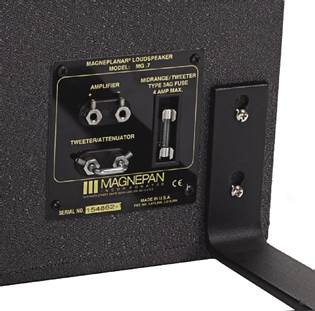
form in front of me as I get from our Martin Logan ESL-X electrostatic panels, with solid presence and enormous insight into low level detail such as surrounding echo decays.
Should you be wondering, the LRS has a warmer balance than an electrostatic, mainly because it doesn’t radiate as much high frequency power (smaller high frequency radiating area). But at the same time magnetic planar drive units have a wonderfully dark, damped quality that is alluring. Eminent Technology loudspeakers from the brilliant Bruce Thigpen taught me that.
Box loudspeakers suffer sound from inside coming out through the cone, delayed by up to half a second. Open baffle loudspeakers don’t suffer this and you get subjectively obvious cleanliness, where singers are not singing through subliminal delayed background muddle. I locked into the pristine clarity of gong strikes on Safri Duo’s Samb Adagio: they glowed in pure space. But this is a bass test track and is what I must talk about next.
In our large listening room the LRS lacked deep bass, in spite of Magnepan’s efforts to overcome this drawback of open panels. A smaller, more bass resonant room than ours (6550 cu ft) would help, but then the room starts to affect bass quality. The opening bass line
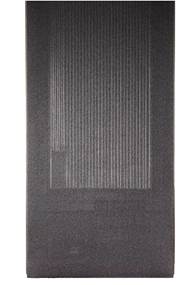
At left the narrower tracks of the vertical line tweeter. From front, the dark patch at lower left identifies this unit.
in Gates of Istanbul was firm and clean, with more inner detail than that from box loudspeakers, but it lacked the low end rumble that is usually there. There was a sense of light low bass and no deep bass.
Little difference between our Creek Evolution 100A transistor amplifier and our Icon Audio Stereo 30SE, other than the latter could go only loud-ish. The Creek kept its composure at high volume, underlining the need for a powerful amplifier.
The sound stage is not only large and perfectly focussed, but also cohesive. There was a sense of solid weight to singers that was a small step up on even an electrostatic. Add in enormous resolution of background atmosphere picked up by the mic and I heard a sound that was beyond any cone driver, box loudspeaker. I was beyond impressed: the LRS is ahead of most loudspeakers, whatever their price, except for absence of deep bass. Dare I suggest a box subwoofer could be used? It’s like invoking Satan in this context!
CONCLUSION
Magneplanar’s new LRS is a loudspeaker that you really should hear. It is very obviously a step up on all around it in terms of clarity, smoothness and insight. Stereo sound staging and image sharpness are also better than all other loudspeakers at this price. Only the tall Martin Logan electrostatic panels match the LRS here, but you pay more.
I suspect lack of deep bass will be a deal breaker for many, something a small subwoofer would alleviate. The LRS could usefully be better finished too, it is drab and idiosyncratic; an option pack would help.
These issues apart, the LRS is arguably the best loudspeaker available under £ and it would be in contention for that title at £. Well worth hearing.
MEASURED PERFORMANCE
Panel loudspeakers lack warmth if engineered for flat frequency response. Lift at low frequencies is applied to give subjective balance and this can be seen in our frequency response analysis. Output of the bass panel rolls down above 350Hz to meet the treble unit just above 700Hz.
Tweeter level is effectively -4dB down but output lifts in the 6kHz-10kHz region, adding presence to upper treble. The upper midrange around 3kHz is not as strong as that from modern cone loudspeakers, so the 0.7 will sound warmer.
At rear a removable link can be replaced by a resistor to pull down high frequency output. A 1 Ohm resistor reduced treble by 2dB.
Panels can suffer uneven dispersion due to cancellations. Here the 0.7 was reasonably consistent vertically but is smoothest low down, around 1ft above the floor – likely why it has a backward tilt.
A vertical line tweeter has good lateral dispersion and that was the case with these ‘speakers.
Interestingly, there is a bass peak around 50Hz to enhance low bass – another area where open panels are lacking due to side cancellation by out-ofphase front / rear waves, especially in a panel as narrow as the 0.7.
Although impedance measures a low 4.7 Ohms, causing heavier current (and power) draw, the 0.7 is insensitive, producing a low 77.4dB sound pressure level (SPL) at 1 metre. Box loudspeakers are typically 10dB more sensitive. Amplifiers of at least 40 Watts are needed and 100 Watts is best for high volume. Our impedance trace shows the 0.7 is purely resistive right across the audio band – ideal as there is no reactive energy storage.
The 0.7 has been well tailored to give a reasonably smooth forward response but it will sound warmer than most loudspeakers. It is insensitive and needs plenty of power to go loud. NK
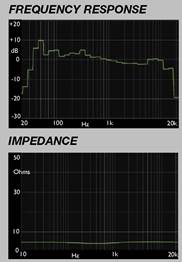
MAGNEPLANAR 0.7 LRS
OUTSTANDING – amongst the best
VALUE – keenly priced
VERDICT
Decent Audio
+44 (0)56 0205 4669
www.decentaudio.co.uk






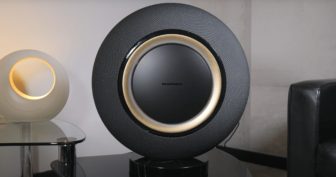
Quite confused. Which speakers are you reviewing? The LRS and the .07 are completely different speakers. But you keep referring to the “.07LRS”. Not sure sure which you are talking about?
The .7 by the looks of impedance and sensitivity..